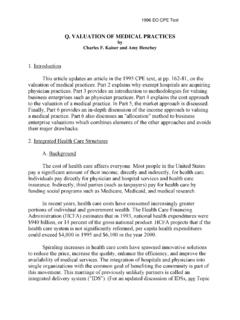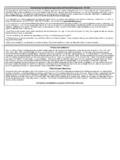Transcription of pocket payments for treatment of non- communicable ...
1 DISCUSSION PAPER NO. 2 Geneva 2011 Impact of out-of- pocket payments for treatment of non- communicable diseases in developing countries: A review of literature Department of Health Systems Financing HSS/ IIMMPPAACCTT OOFF OOUUTT--OOFF--PPOOCCKKEETT PPAAYYMMEENNTTSS FFOORR TTRREEAATTMMEENNTT OOFF NNOONN--CCOOMMMMUUNNIICCAABBLLEE DDIISSEEAASSEESS IINN DDEEVVEELLOOPPIINNGG CCOOUUNNTTRRIIEESS:: AA RREEVVIIEEWW OOFF LLIITTEERRAATTUURREE by Priyanka Saksena, Ke Xu and David B. Evans Discussion Paper No 2 Geneva 2011 Department "Health Systems Financing" (HSF) Cluster "Health Systems and Services" (HSS) HSS/ 1 SUMMARY The burden from non- communicable diseases is growing. At the same time, there is an increased focus on ensuring that people are protected against financial risks due to accessing care. In the context of these trends, a literature review to understand household financial burden due to NCDs was undertaken.
2 The review found that households with NCDs spend a substantial share of their income on care for these diseases. Spending was even higher for hospitalization related expenditure. Some households faced catastrophic health expenditure and impoverishment as a result of spending. In addition, some households' longer-term financial status was also adversely affected through the accumulation of debt and other risk mitigating strategies. Undoubtedly numerous people also simply forgo needed care for NCDs as a result of financial barriers. Policies that increase financial risk protection offered to households with NCDs need to be implemented as part of broader social protection strategies. HSS/ 2 INTRODUCTION Universal health coverage has two important components. The first is the extent to which people are covered by the health services that they need. The second is the degree of financial risk protection they have in using services - do they suffer financially as a result of having to pay for the services they need.
3 The World Health Repot Report of 2010, entitled Health Systems Financing: the Path to Universal Coverage showed that over a billion people are unable to use the health services they need, while a 100 million people are pushed into poverty and 150 million people face financial hardship because they have to pay directly for the health services they use at the point of delivery (Xu et al. 2007; World Health Organization 2010). While it is clear that the burden of non- communicable diseases is growing and is already a major problem even in the poorest countries, the questions of whether people have access to the services they need to prevent or control these diseases, and the extent to which they suffer financial catastrophe or impoverishment in obtaining the services they need is less well researched (Daar et al. 2007; Boutayeb 2006). This paper focuses on the second part of the universal coverage question, the impact of non- communicable diseases (NCDs) on the household finances of people who suffer from them.
4 Arriving at an accurate understanding of the household financial burden from NCDs would require national household surveys that seek information on the financial consequences of care-seeking behaviours. Respondents would also need to be able to identify accurately if their care-seeking is related to a non- communicable disease. There is little evidence of this nature, although it is growing, but even then it is important to reflect on whether respondents are able to accurately indicate whether their expenditures are really attributable to a non- communicable condition. Most of the available studies focus on a specific type of non- communicable disease and hence are not sufficient for understanding the complete burden on households from all NCDs. Nonetheless, any literature on the topic provides useful evidence on the effects of NCDs on financial risk protection. In this paper, we undertake a literature review on household financial burden from non- communicable diseases and provide consolidated evidence on the topic to policymakers and well as to highlight areas may need more research.
5 METHODOLOGY We conducted a review of journal articles and other documents on the household financial burden from NCDs in developing countries. We searched the Scopus search engine, which is an abstract based platform, for journals in the domains of: life sciences; health sciences; physical sciences; and social sciences and humanities. We searched for all combination of terms: non- communicable diseases; chronic; diabetes; cardiovascular disease; and cancer with the terms: finance; poverty; financial burden . In this paper, we present all the literature that was found and which allowed us to identify the key financial impacts on households. The literature is quite varied in terms of methodology. Much of the literature on chronic diseases does not identify clearly if the focus includes chronic conditions outside of the disease complex of NCDs but we excluded data relating to communicable chronic illnesses where possible.
6 Frequently, the household financial burden (and derived statistics) in these studies is only available for those who have NCDs or chronic illnesses, which is a less accurate way of identifying the true financial burden than if the studies reported expenditure for households with and without the illness. Lastly, this review simply extracts the results related to household financial burden from each study without commenting on the merits of methods that were used in each paper. The findings from the literature were grouped into two sections: studies looking at NCDs in general; and studies looking at specific NCDs. For the latter, we have further grouped studies according to the disease they examine. Within these groups, the studies are presented according to alphabetical order by country. RESULTS Household burden due to non- communicable and chronic illnesses combined In many of these studies it was not possible to be sure that the focus is limited to chronic non- communicable diseases.
7 Brazil: The study focuses on the richest people in an employer-based insurance scheme in Sao Paolo. Its findings suggest that among the richest, non- communicable diseases are responsible for more than 50% of the claims for highest spenders in the private health insurance plan.(Kanamura & D Avila Viana 2007) HSS/ 3 Burkina Faso: A subsample of 800 households from the Nouna Health District household survey was used to look at the incidence of catastrophic health expenditure. The study employed different thresholds of non-food expenditure (from 20-60% of non-food expenditure) to calculate the incidence of catastrophic health expenditure. Using multivariate regression analysis, it found that when a household member has a chronic illness, the odds of catastrophic financial consequences associated with paying for health services increased by between and fold. (Su et al. 2006) China: 6157 households in Shandong and Ningxia were sampled using a multistage random design.
8 The study compared expenditures of members of the New Cooperative Medical Scheme (NCMS), a voluntary health insurance scheme for rural residents, with non-NCMS members in the same areas. Reimbursement from the NCMS was quite low and only of the expenditures of the households seeking care for chronic illnesses was reimbursed in Ningxia and in Shandong. Pre-reimbursement health expenditure on medicines and health services relating to chronic diseases among NCMS members accounted for an average of 27% of their annual non-food per capita expenditure in Shandong and 35% in Ningxia. For non-NCMS members, spending on chronic conditions was 47% and 42% of non-food expenditure in Shandong and Ningxia respectively. The financial burden on poor households was generally higher than the burden for richer households. Between 14-21% of families in both provinces suffered from financial catastrophe because of these expenditures, defined as spending more than 40% of their non-food expenditure on chronic healthcare costs.
9 (Sun et al. 2009) China: 671 households in enrolled in the Medical Financing Assistance scheme in Wuxi and Qianjiang were interviewed. These households were all living below the official poverty line. Using multivariate regression analysis, the study found that households where there was at least one member with a chronic illness were 50% more likely than other households to have incurred debts of greater than 500 RMB (about US$ 60 at that time). (Hao et al. 2010) China: 3,340 households in six counties in Hebei and Shaanxi provinces were included in the study. The study uses a poverty threshold of US$ 1 per person to examine the proportion of the population pushed under the poverty line because of health expenditure. The presence of chronic illness in the household was measured by the number of chronic illnesses over the number of members in the household. Among households with no chronic illness, only were impoverished due to health expenditure prior to reimbursement.
10 However, among households with chronic conditions, between were impoverished due to health expenditure prior to reimbursement. Additionally, using multivariate regression, the study found that in the presence of chronic illness the odds of impoverishment increased by times before reimbursement. However, after taking reimbursement from the various insurance programs into account, the odds of being impoverished in the presence of chronic illness was actually lower than for other households. (Shi et al. 2010) India: The study focused on households with illness episodes in five resource poor locations in rural India. A total of 2,204 households within the catchment area of a few micro-insurance schemes were included in the analysis. Using multivariate regression, the study found that the cost of chronic illness was higher than the cost of non-chronic illnesses but no details of what impact these costs had on families, nor how much was reimbursed by the insurance schemes was provided.














